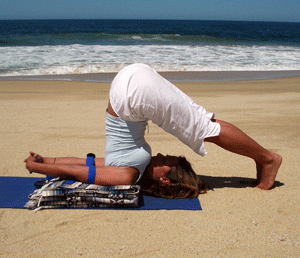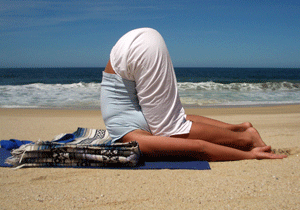 |
|
| Site Areas |
store | | | articles | | | forums | | | studios | | | vacations |
| yoga | massage | fitness | wellness | readings | ask the expert | |
The Shoulder Stand (Salamba Sarvangasana)YogiSource.com Staff©Yoga People, LLC 2017 
Pronunciation: (saw-LOM-baw sar-van-GAWS-ahna) Translation: In Sanskrit, salamba means with support. Sarva means all and anga means limb. Next to Sirsasana (the headstand), this posture is considered one of the most beneficial of the asanas. Shoulder stand is known as the "Queen of Asanas" and is typically done after the headstand, the "King of Asanas." An inversion reverses the effects of gravity and brings oxygen-rich blood to the vital organs including the brain. Experienced practitioners experience often report that their daily practice of inversions is like a drinking draught of wonderfully delicious nectar. "Inversions cultivate the yogic mind." -- B.K.S. Iyengar To protect the body from possible injury in Sarvangasana the bodyís weight should be primarily borne by the skeletal system rather than muscles and the neck should have its normal curve. Although it is possible to do Sarvangasana with no props we recommend their use to minimize risk of physical injury. Technique: Prepare by putting down a yoga mat. Make a neat stack of three or more firm blankets. Fold each into a neat rectangle and very carefully align them with the folded edges on top of one another. Place the folded edges toward the middle of the mat with the blankets at one end of the mat. The stack should be a bit wider than your shoulders and deep enough so that they will support your upper arms when they are placed behind you in the pose. In the pose your shoulders should be at the forward edge of the stack with your head on the floor and the neck arching down between them. The stack should be high enough so that there is no compression of the cervical vertebrae in the neck and no tightness in the neck muscles. Use as many folded blankets as necessary to relieve neck strain and tightness. Most people initially need three or four folded blankets. Over time, as your neck muscles lengthen, you will find that you can lower the height of your stack of blankets. In the pose, position your arms behind you and bend them so your hands support your back as low down towards the shoulders as possible. The support from your bent arms will help you get more lift in your spine. The hands can best support your back if the upper arms are parallel on the blankets or mat. However, most people find that their elbows tend to splay out when they do this. If your elbows do move out make a looped strap as wide as your shoulders and position it around your upper arms just above the elbows. You will be able to support your torso much more strongly this way. Before starting the pose have a strap handy and adjusted to the approximate width. If you have long hair, tie it up on the top of your head so it wonít be pulling in the pose if it gets caught. Position your strap over both arms just above your elbows and lay back on your stack of blankets with your arms by your sides and your shoulders just far enough from the edge so that when you roll up so that your spine is perpendicular your shoulders will be just inside the edge of the stack of folded blankets. Now it is time to press down with the arms and roll the torso up. For some this is easier if, after positioning your shoulders properly in a prone position you sit up and the lie back and curl the torso and legs up in one fluid motion.
In Sarvangasana, position yourself so that you are positioned as close to the top of your shoulders as possible. One way to do this is to shift the weight onto one shoulder and then pushing the elbow of the second arm away from your back so that you can come higher onto the top of the second shoulder. Now, shift the weight to the newly adjusted shoulder and come higher onto the first shoulder. When making this adjustment avoid the tendency to "walk" the shoulders back on your stack of blankets loosing the free arch of your neck between the blanket edge and the mat. When you are on the top of the shoulders you should be aligned vertically as in Tadasana. When viewed from the side, your outer shoulder joints, outer hip joints, outer knee joints and outer ankle joints should be stacked over each other in a straight line perpendicular with the floor. As you stay in the pose, occasionally adjust your hands down your back a bit more and lift up through your legs more. Bringing the hands down the back toward the shoulder blades will align your torso so it is perpendicular to the floor. Your sternum opens toward your chin as your armpit chest area lifts and rotates in the same direction as the sternum.
Keep the inside edges of your flexed feet touching and lifting up so that a pencil held between them would not slip out and fall and would be pushed towards the sky. Look up align your front body so that your navel is on the straight line up and your legs are not leaning to either side. Some people have difficulty keeping a firm pressure between their upper arms and their blankets. If this occurs in your pose, place a yoga mat folded or rolled high enough to provide a firm base for the upper arms under the position where the elbows will be positioned prior to coming into the pose. Do not turn your head from side to side in Sarvangasana as this strains your neck.
The feet are flat, on a parallel plane with the ceiling with big toes and ankle bones next to one another. Constantly adjust different parts of the pose as your awareness circulates in the body. Eventually the pose will become easy in as you find your balance and alignment. When you are ready to come out of the pose, bring one leg and then the other down to the floor into Halasana. Slide your arms out of your strap bend your knees, round your back and roll out of the pose so you are lying on your back. Sarvangasana will give you optimal benefits if you do the pose for a period of five to ten minutes daily. In any case if you do Sirsasana, the headstand in your practice you should follow it by Sarvangasana held for at least as long a period of time as you have held Sirsasana. Beginners Tip: Many beginners in this pose find that they cannot yet get high enough onto their shoulders to have a straight spine that is perpendicular to the floor. Those people can still do the pose with a straight spine that is not yet fully perpendicular using a fold up chair as a prop.
Benefits: The thyroid gland works better with an effect on metabolism and weight.
Cautions: Donít do the pose during menstruation. Donít do the pose if you have thyroid disorders.
Do not attempt the pose if you have breathing difficulties or pain in the upper spine. Sarvangasana is considered to be an intermediate to advanced pose. Do not perform this pose without sufficient prior experience or unless you have the supervision of an experienced instructor. Remember that this is a shoulder stand and not a neck-stand. Practicing yoga asks for your mindfulness. You are responsible for your own practice and knowing what is right for you in the each moment. We suggest that you learn the pose with a teacher that you trust. Thanks to Victor Oppenheimer for editing this article. Copyright Yoga People LLC |
| about us | contact | privacy | site map | careers | |

|
|

